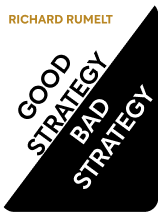

This article is an excerpt from the Shortform book guide to "Good Strategy Bad Strategy" by Richard Rumelt. Shortform has the world's best summaries and analyses of books you should be reading.
Like this article? Sign up for a free trial here .
What is Richard Rumelt’s Good Strategy, Bad Strategy about? What makes a good organizational strategy according to the author?
In Good Strategy Bad Strategy, Richard Rumelt lays out the essential components of good organizational strategy and the faulty thinking behind a bad strategy. He also describes specific and measurable techniques for designing a focused strategy that gives your organization the best chance of success.
Below is a brief overview of Good Strategy, Bad Strategy by Richard Rumelt.
Richard Rumelt: Good Strategy, Bad Strategy: The Difference and Why It Matters
Richard Rumelt is one of the world’s foremost thinkers on strategy, having guided organizations ranging from small, entrepreneurial start-ups to large, multinational conglomerates, as well as several governments and the U.S. Department of Defense.
In his book Good Strategy, Bad Strategy, Richard Rumelt defines the elements of a good organizational strategy and explains how to design a strategy that capitalizes on your strengths while fixing your weaknesses. Below is a quick summary of the key points.
The Two Truths of Strategy
To properly understand strategy, we must start by exploring two fundamental truths underpinning strong strategy:
1) Just Having a Strategy Is a Strategy
Remarkably, simply having a strategy is a strategy. Most organizations operate reactively to challenges on a day-to-day basis, having only a fuzzy outline of long-term goals that they mistakenly call “strategy.” Thus, when an organization has a well-thought-out and specific strategy, it has an advantage over its competitors simply because it is better prepared for the challenges that face all rivals in an industry.
Apple’s turnaround under Steve Jobs in the late 1990s illustrates this advantage. By the time Jobs returned to the company as CEO in September 1997, Apple was losing market share to Microsoft and was heading for failure. Within a year, Jobs had turned the company around by cutting Apple back to a simplified, small, strong core and eliminating anything that didn’t serve that core. In doing so, he identified the fundamental problem of the company—it was unfocused—and then developed a coordinated set of actions to address that problem. He was able to turn the company around by instituting a clear, explicit strategy instead of merely, as his predecessor had done, trying a bit of this and a bit of that.
2) A Good Strategy Uses Hidden Strengths
Above all else, good strategy leverages strength against weakness, especially, if possible, an unexpected strength against an unknown weakness, taking your competition by surprise. The success of Walmart illustrates this technique. In the 1970s and 1980s, Walmart was a small, regional store while the industry leader, KMart, was large, national, and well-established. Everyone saw KMart’s size and its decentralized structure as strengths, but Walmart recognized those traits as weaknesses, because they prevented the company from responding quickly to competitive challenges. When Walmart proved how efficient a centralized, networked hub controlling its various locations could be, KMart’s size and its ingrained individualized culture prevented it from reorganizing into a similarly networked structure. In 1990, Walmart surpassed KMart in size.
Bad Strategy
Now that we’ve explored a bit of what makes good strategy, let’s look at what makes bad strategy. Bad strategy is not simply the absence of any strategy, nor is it good strategy that has failed. Rather, it is poorly-thought-out strategy that’s based on misconceptions and misguided leadership.
There are four elements of bad strategy and three influences that cause it.
The Four Elements of Bad Strategy
Bad strategy has four characteristics:
- Fluff: Bad strategy relies on unnecessarily grandiose phrasing and vocabulary to create an illusion of expertise.
- Failure to identify the challenge: Bad strategy does not properly define the specific challenge the organization faces. When you don’t explicitly name the problem, you can’t properly address it.
- Conflation of goals with strategy: Bad strategy focuses on profit or performance goals instead of methods to overcome challenges.
- Misguided strategic objectives: Bad strategy fails to narrow down its scope, instead trying to focus on too many objectives. It also chooses unrealistically ambitious objectives but does not provide useful guidance on how to achieve them.
The Three Causes of Bad Strategy
Now that we’ve defined bad strategy, let’s explore what causes people to create bad strategy. There are three primary reasons behind bad strategy:
- The inability to choose between competing values and priorities: Often, complex organizations don’t want to choose among the various and diverse interests within their operations to develop a focused, targeted strategy that concentrates resources into one specialty. For example, Digital Equipment Company was a computing pioneer whose CEO couldn’t reconcile the competing priorities of three of its top executives. Instead of choosing one priority and focusing on that, the CEO tried to incorporate all three competing visions and ended up with an unfocused strategy. The company floundered and eventually was acquired by rival Compaq.
- The lure of strategy-by-template: Strategy writers will sometimes turn to template-style tools with generic prompts designed to ease the process of designing strategy. Unfortunately, these prompts encourage vague statements of goals and ambitions, rather than clear analyses of challenges and solutions. You’ll often see them in business plans or annual reports, with fill-in-the-blank sections like the following:
- Vision: Where do you see your company in the future? (Here, strategy writers often use words like “the best” or “most profitable.”)
- Mission: What is your purpose? (This often sounds lofty, mentioning “passion” and “innovation.”)
- Values: What are your company’s values? (These are typically non-controversial values; think “respect” and “integrity.”)
- Strategies: What are some goals and subgoals that you can call strategies? (You’ll see words like “portfolio” and “management.”)
- The false promise of positive thinking: Many leaders center their “strategy” around motivational, can-do language, as if the most important element of strategy is wanting success strongly enough. However, ambition alone isn’t enough to propel a company to success. For example, Steve Jobs is often lauded for his visionary thinking, but ambition had less of an impact on Apple’s success than competence and a specific competitive advantage: the technological development that allowed the Apple II to directly connect to the floppy disk rather than using expensive controllers.
Good Strategy Starts With a Kernel
At the core of good strategy lies a basic underlying structure that unites thought and action called the “kernel.” The kernel has three elements:
- Diagnosis: a definition of the challenge and the most critical aspect of it. Sometimes different people will have different views on what the correct diagnosis of a problem is. A leader’s challenge is to recognize this and to look for a better diagnosis when needed. For example, when IBM faced difficulties in the early 1990s, many said the company was too integrated and advised that it break itself up and specialize in something more narrowly-focused. The company’s CEO, though, diagnosed the problem not as too much integration but as not enough: a lack of internal coordination between teams. Solving that problem allowed the company to regain dominance as an integrated provider of customer solutions.
- Guiding policy: a clearly outlined approach to cope with the challenge identified by the diagnosis. A guiding policy draws upon an organization’s sources of advantage and focuses a company’s efforts toward targeted objectives that meet the challenge. For example, Wells Fargo’s corporate vision aims to satisfy all of its customers’ financial needs, and it supports this ambitious goal with a guiding policy of cross-selling.
- Action plan: a set of actions that work with each other to accomplish the guiding policy. An action plan coordinates a variety of operations to carry out the guiding policy. It defines resources, policies, and movements that support one another. For example, a company with a simple and clear competitive advantage like, say, being a low-cost retailer, will have interrelated policies affecting sales, marketing, distribution, and design that will mutually support each other in order to keep prices low.
Nine Elements of Good Strategy
Let’s now look more closely into the specific things you can do to develop good strategy.
1. Leverage Your Strengths
In the same way that a lever focuses all your strength onto a single, pivotal point, a good strategy focuses mental energy, resources, and actions onto a crucial objective that causes other objectives to fall into line. To properly leverage your strengths:
- Use predictions to point you in the right direction: Figure out what’s most likely to happen to your company or industry in the future and direct your efforts accordingly.
- Choose pivot points to center your leverage: Pivot points are opportunities where focused energy will have the most effect. They are usually imbalances in a situation—in other words, an area where one rival has an outsized advantage over another in capability, resources, or insight. For example, you might have the ability to offer a wider selection of beverage options to your customers than your rivals; if this is important to your particular customer base, focus on this point.
- Concentrate your efforts to magnify their effects: You only have limited resources, and coordinating them towards one goal will have a more significant effect than spreading them thinly.
2. Press Your Advantages
Ultimately, a good strategy identifies your strengths—in other words, your advantages—and then presses those advantages in one (or more) of four ways:
- Increasing your advantage by reducing its costs, increasing its value to customers, or both
- Broadening your advantage by applying the skills underpinning the advantage to new fields. For example, after finding some success in explosives, DuPont applied its expertise in chemistry to household products.
- Increasing demand for your advantage by either increasing the number of buyers or increasing the amount each buyer demands. For example, Roll International created demand for its pomegranate juice through an aggressive marketing campaign extolling its health benefits.
- Limiting your rivals’ ability to replicate your advantage either through legal means (patents) or by constantly innovating, making it difficult for rivals to keep up.
3. Look for Internal Weakness
When planning your organization’s strategy, focus not only on your opponent’s weakness but also on your own. Think of your organization as a chain; the chain as a whole isn’t strong if it has an internal weakness—a weak link—that might one day break it. Examine your organization for such a weakness, and once you’ve identified it, focus on strengthening that.
It’s important to focus on any weaknesses you might have because strengthening already-strong links while neglecting weak ones will divert resources from where they’re needed most to an area that will not ultimately earn you a high return on investment. For example, between 1980 and 2008, General Motors (GM) invested much time and money into improving the quality of their already-well-built transmissions, but didn’t address problems like faulty dashboard knobs and rattling door panels. Improving the transmission did little to entice customers who cared about the shoddy quality elsewhere to buy GM cars.
4. Watch for Inertia and Entropy
Good strategy anticipates inertia—an organization’s resistance to change—and entropy—the way an organization tends to devolve into a state of chaos if it’s not actively managed.
Inertia can arise from the entrenchment of habits, policies, or an organization’s culture and beliefs. It can also arise when a company’s customers are slow to adapt to an industry change and the company doesn’t want to lose those immediate sales in order to chase future sales. For example, when customers are satisfied with low-interest-rate savings accounts even though prime interest rates have risen, a bank might be slow to offer higher rates knowing their own customers won’t complain. In doing so, the bank misses out on new business from customers who shop around for rates.
Entropy happens when an organization loses its edge because a lack of ongoing competition allows it to grow complacent. You can see entropy when a company produces a wide, unfocused range of products, when prices are set low to please the salesforce instead of because it’s the best competitive strategy, or when executive bonuses outpace the value of the company.
Inertia and entropy can pose great threats to an organization but also great opportunities. Sometimes, an organization’s biggest challenges are its own inertia (internal stasis) and entropy (inefficiency). However, an organization that takes advantage of other organizations’ inertia and entropy can leapfrog their success. Understanding these influences can help you avoid their possible negative effects and exploit their potential.
5. Narrow Your Focus
At its heart, good strategy is about focus: A leader must identify one or two critical issues facing her organization and then come up with a plan to direct actions and resources at these issues, to the exclusion of other, less-critical issues that might distract from this focus.
Often, this means that a company will narrow its target market down to a smaller segment or will pass up opportunities to provide additional services if those services dilute its focus. For example, Crown Cork & Seal, a metal can manufacturer, was more profitable than its larger, more established rivals because it targeted a niche market. Instead of supplying long-term production runs for the major beverage companies as its competitors did, Crown offered short-term, smaller runs that could be tailored for a customer’s specific needs, such as seasonal orders or unexpected demand surges. This tight focus allowed the company to control price negotiations more effectively and gave it better command of its operating logistics.
6. Choose Feasible Objectives
If goals are the ultimate driving force behind a strategy, objectives are the smaller, sub-goals that plot out the path to achieving the overarching goals. When choosing objectives, it is crucial that leaders pick ones that are feasible—ambitious but reasonable given an organization’s resources. Goals that outpace your current capabilities are inherently unachievable, and will result in wasted time, wasted energy, and decreased morale. An example of an unfeasible objective was the “War on Drugs” in the 1980s and 1990s. Calling for the complete cessation of illegal drug use was not realistic given existing law-enforcement capabilities.
7. Beware of Chasing Growth
A good strategy recognizes the difference between organic, healthy growth and manufactured, unhealthy growth, and resists the temptation to grow just for the sake of growing. Healthy growth comes from a combination of growing demand and expanded capabilities. Unhealthy growth is forced through acquisitions that may not fit a company’s original strategic vision. Mergers don’t always produce the cost savings managers expect, and can result in loosely integrated, unfocused conglomerates that end in failure. For example, Crown Cork & Seal lost sight of its focus in the 1990s and went on an acquisition spree, which diluted their profits and drove their stock prices down.
8. Treat Your Strategy Like a Design
A good strategy is a well-integrated, tight design made up of parts working together to form a coherent whole—like a car, which is more than the sum of its parts. Consider the needs of your organization when deciding how complex and highly integrated your strategy design will be. The greater the challenge facing an organization, the greater its need for a cleverly-designed strategy, but, in the face of lesser challenges, a less-highly-integrated design may be preferable. There are costs to highly efficient designs: namely, increased development difficulties, more supervision to implement, and less flexibility. For example, a race car has a much higher degree of design integration than a Honda CRV, but the race car is not appropriate for as many purposes as the Honda.
9. Anticipate Change
To position your organization so that competitors will have an uphill battle overtaking it, anticipate fundamental shifts in the landscape and exploit them before others do. Fundamental changes come from a variety of sources, including rising costs, deregulation, changes in technology, and changing buyer preferences. Predict how these changes will affect your industry or the wider landscape and look for opportunities that might be created. Look not only for direct effects of these changes but also for secondary effects, which may be equally profitable but less initially obvious.
For example, the advent of television in the 1950s brought free, accessible entertainment into peoples’ homes. Established film production companies had, until then, made money on a steady stream of mediocre movies, but competition from the free, in-home entertainment provided by television meant that by the 1960s, movie audiences had shrunk significantly. What ultimately revived the movie industry was a shift to independent films, where studios financed independent producers and directors to create higher-quality movies that would entice audiences into the theaters again. Thus, the rise of an independent film industry became a secondary effect of the technological change of television.
Additionally, when assessing change and predicting how it will play out, try to visualize the “ideal state” of an industry: the way an industry would work if it met the needs of customers as efficiently as possible. This will usually reveal the ultimate direction of an industry, as organizations generally evolve towards, not away from, efficiency, and buyers are innately drawn to solutions that meet their needs with the least amount of trouble.
How to Think Like a Strategist
Now that we’ve examined a variety of elements that go into the making of good strategy, let’s look at techniques and approaches you can use to incorporate these elements into your own strategic planning. There are three general guidelines you can adopt that will help clarify your thinking:
1. Think Like a Scientist
Use the scientific method to think like a scientist. This method involves a researcher testing a hypothesis—a prediction of how the world works—by observing if it holds up to experimentation in real life. A strategy is a type of hypothesis, and as strategists, we must measure its value by examining its success in practice.
Often, a hypothesis starts with “anomaly,” or something that grabs your attention because it represents a difference between what you observe and what you expect. In the world of science this might mean questioning why snow doesn’t melt as fast as you’d expect it to when the weather warms up (leading to the discovery of thermodynamics). In the business world, an anomaly might make you wonder why there are no upscale products offered by American fast-food companies (leading to Howard Schultz’s development of the coffeehouse chain, Starbucks). Recognizing an anomaly can lead you to unexpected opportunities that have been heretofore overlooked by competitors.
2. Think Like an Analyst
To think like an analyst, consciously and carefully examine your challenges and options. Some techniques you can use include:
- Making a list of your challenges and opportunities: This focuses your mind and reminds you of long-term priorities that you might lose sight of in the day-to-day running of your organization.
- Looking for alternative options to obvious solutions: This ensures you are not ignoring a potential solution hiding in the shadows.
- Making judgments: In the end, strategy is a judgment call, and committing to such a call gives you a starting point from which you can evaluate other action plans, priorities, and diagnoses of challenges. Sometimes choosing among endless options is more difficult than deciding between two, and if you commit to one option, it’s easier to evaluate other options by asking are they better or worse than this particular one.
3. Avoid Common Faulty Biases
Strategy failures are often the results of failures of thinking, and typically can be categorized into one (or more) of five common faulty biases:
- The “engineering overreach” bias: where strategy designers fail to analyze or comprehend the ways in which their design can fail, as well as the consequences of such failure. For example, the innovative financial instruments created in the 2000s that led to the financial collapse of 2008 were not well understood by either the bankers who sold them or their customers—and no one fully understood the consequences of the system failing.
- The “smooth sailing” bias: where people believe that when things are going well, they will continue to go well. Unfortunately, some designs are built with a critical design flaw that doesn’t reveal itself until it is catastrophically triggered. Consequently, there might be no warning tremors until all at once, the entire design collapses—such as happened in the 2008 financial collapse mentioned above.
- The “risk-seeking” bias: where people are incentivized to seek risks because they will keep profits if things go well but other people will shoulder the loss if things go poorly. This behavior can be seen in the financial industry when banks take on more debt than they can cover expecting to eventually get bailed out by the government if their bets don’t work out.
- The “social herding” bias: where people ignore obvious problems simply because other people are ignoring them. When everyone shares the same level of misunderstanding, they end up in a “blind leading the blind” situation, with everyone believing that everyone else knows what they’re doing, even when that’s not the case. This bias again partly explains what happened leading up to the 2008 financial collapse. Everyone assumed that because everyone else was betting big on mortgage-backed securities, the strategy must be sound.
- The “inside view” bias: where people see themselves, their group, their organization, their country, or their era as different and special, believing that what happens to other people can’t happen to them. The 2008 collapse again provides a good example of this. People believed America’s financial markets were robust enough to absorb shocks and that the Federal Reserve was skilled enough to prevent them, ignoring the fact that the stock market rise was simply another real-estate-fueled bubble like many others before it, and was just as liable to burst.
Each of these biases leads us to ignore important information and aspects of a strategy that might lead to ruin. Be aware of these biases when you encounter them and prepare to push back against them. When you detect such biases in a group of people discussing and designing strategy, look for outside data that might refute such group-think.

———End of Preview———
Like what you just read? Read the rest of the world's best book summary and analysis of Richard Rumelt's "Good Strategy Bad Strategy" at Shortform .
Here's what you'll find in our full Good Strategy Bad Strategy summary :
- The essential components of good strategy and the faulty thinking behind bad strategy
- Specific and measurable techniques for designing a focused strategy for success
- How to overcome challenges and gain a competitive edge






